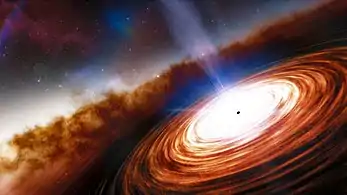J0313–1806
J0313–1806 is the most distant known quasar at z = 7.64.[1] In January 2021, it was identified as the most redshifted (highest z) known quasar, with the oldest known supermassive black hole (SMBH) at 1.6±0.4×109 solar masses.[2][3][4] The 2021 announcement paper described it as "the most massive SMBH at z > 7".[1]:4
| J0313–1806 | |
|---|---|
| Observation data (Epoch J2000.0) | |
| Constellation | Eridanus |
| Right ascension | 03h 13m 43.84s |
| Declination | −18° 06′ 36.4″[1] |
| Redshift | 7.642[1] |
| See also: Quasar, List of quasars | |
One of the 2021 paper authors, Feige Wang, said that the existence of a supermassive black hole so early in the existence of the Universe posed problems for the current theories of formation since "black holes created by the very first massive stars could not have grown this large in only a few hundred million years".[3]
Gallery
 An artist's impression of quasar J0313–1806 showing the supermassive black hole and the extremely high velocity wind.[5]
An artist's impression of quasar J0313–1806 showing the supermassive black hole and the extremely high velocity wind.[5]
References
- Wang et al.
- Maria Temming (January 18, 2021), "The most ancient supermassive black hole is bafflingly big", Science News
- Harrison Tasoff (January 19, 2021), "Researchers discover the earliest supermassive black hole and quasar in the universe", phys.org
- A Luminous Quasar at a Redshift of z=7.64, presentation at 237th Meeting of the American Astronomical Society, January 12, 2021
- "Portrait of a Needle Galaxy". noirlab.edu. Retrieved 1 February 2021.
Sources
- Feige Wang, Jinyi Yang, Xiaohui Fan, Joseph F. Hennawi, Aaron J. Barth, Eduardo Banados, Fuyan Bian, Konstantina Boutsia, Thomas Connor, Frederick B. Davies, Roberto Decarli, Anna-Christina Eilers, Emanuele Paolo Farina, Richard Green, Linhua Jiang, Jiang-Tao Li, Chiara Mazzucchelli, Riccardo Nanni, Jan-Torge Schindler, Bram Venemans, Fabian Walter, Xue-Bing Wu, Minghao Yue (January 12, 2021). "A Luminous Quasar at Redshift 7.642". arXiv:2101.03179 [astro-ph.GA].CS1 maint: uses authors parameter (link)
Further reading
- Alec Fox (January 19, 2021), "This 13-Billion-Year-Old Supermassive Black Hole Is the Oldest Ever Found", Smithsonian
This article is issued from Wikipedia. The text is licensed under Creative Commons - Attribution - Sharealike. Additional terms may apply for the media files.